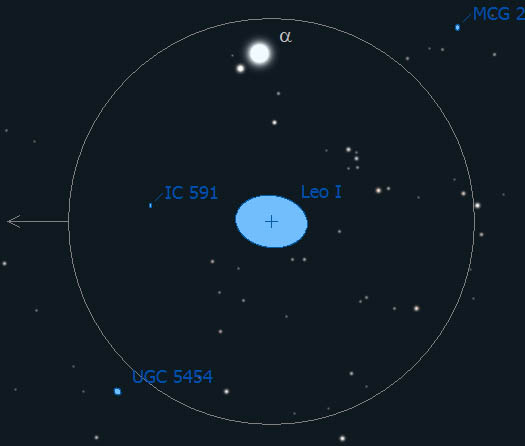 Leo
I is a large low surface brightness Dwarf Elliptical galaxy in our
own local group. Although its integrated visual magnitude is
fairly bright this light is very spread out making it a much more
difficult target than other galaxies of similar brightness.
But even then, Leo I should be a fairly easy object even for small
scopes if observed from a dark site. That is, it would be, if
it weren't within 20' of the bright star Regulus! The
proximity of this bright star makes Leo I all the more challenging
to detect. Leo
I is a large low surface brightness Dwarf Elliptical galaxy in our
own local group. Although its integrated visual magnitude is
fairly bright this light is very spread out making it a much more
difficult target than other galaxies of similar brightness.
But even then, Leo I should be a fairly easy object even for small
scopes if observed from a dark site. That is, it would be, if
it weren't within 20' of the bright star Regulus! The
proximity of this bright star makes Leo I all the more challenging
to detect.
But on the other hand,
finding the correct place to look for Leo I is rather easy.
Just center your telescope on Regulus and sweep due north by about
20'. Use a low power eyepiece because Leo I is quite large and
diffuse.
It's not clear to me
what the minimum aperture is to detect this object. I found
observations by experienced observers using 10 and 12 inch
telescopes, but nothing smaller.
For many telescopes
which suffer from stray light, the trick seems to be to use just
enough magnification to place Regulus outside of the field and no
more. In my 18-inch I used 94x. Regulus was high at the
time, near transit, which aimed one of its large diffraction spikes
right at the galaxy. When I moved the scope north from Regulus
I saw nothing but the glow for the spike. So I tried another
tactic; I moved to a recognizable pattern of stars to the northwest
of Regulus and then swept to the east. As I did this the glow
of the diffraction spike appeared, but I also discerned a large oval
shape blended into the glow from the spike. This was the
galaxy! It was pretty easy to spot once I was able to pick it
out the first time.
Leo I appears as a
large oval glow that is extremely diffuse -- no central
concentration at all could be discerned and none of the stars were
resolved, although I didn't attempt higher magnifications.

The field in an 6-inch at
50x. North is down and east is to the right. |